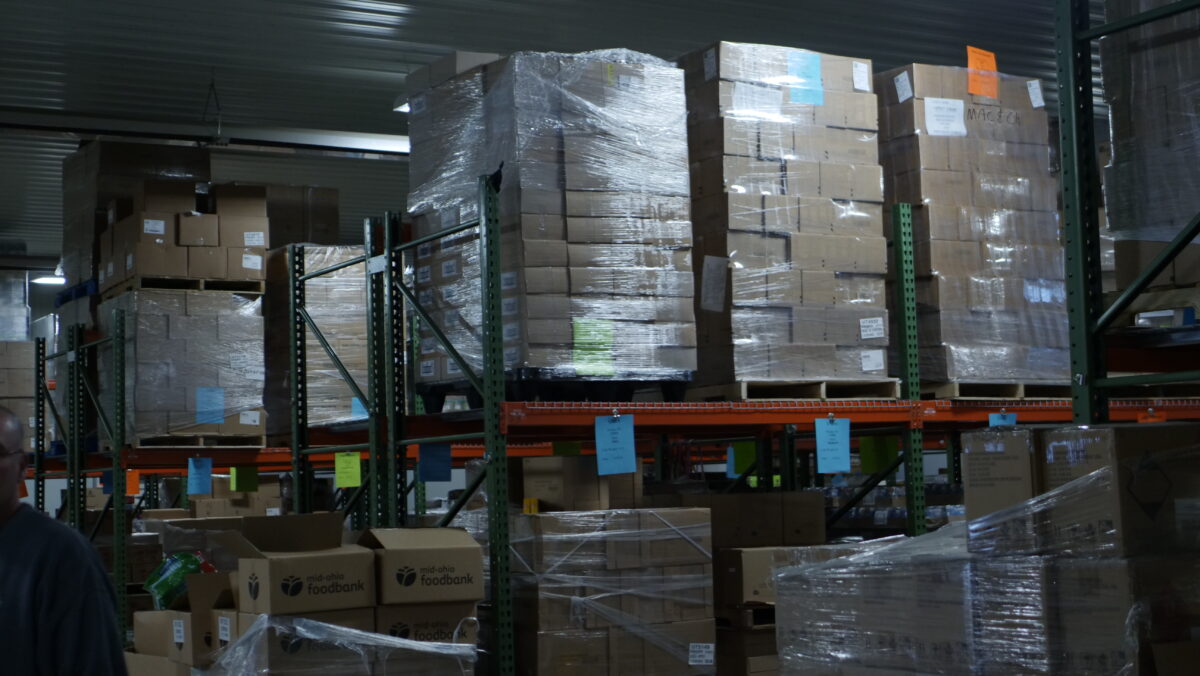The metal warehouse shelves at the Licking County Food Pantry were stocked floor-to-ceiling with cardboard boxes filled with food for distribution on Friday, Jan. 26. And the system is about to change for the better for Licking County residents in need.
The Food Pantry Network (FPN), which operates nearly two dozen volunteer-run pantries in Licking County, receives about 10,000 pounds of food on Monday and another 10,000 pounds on Wednesday each week, Executive Director Chuck Moore said.
“So as you can see, there’s food,” Moore said from inside the warehouse, surrounded by boxes and skids of food towering high over his head.
But the way that food is distributed, Moore said, is going through a significant overhaul: Over the next several months, the food pantry will do away with existing pantry systems and make visiting the pantry more like a trip to a grocery store.
“This empowers the customers to determine what they need in their home, with no explanation needed,” FPN Development Director Alyssa Shepherd explained.
Traditionally, the food pantries have run on service limits, in which the amount of food distributed is based on the number of members in a visitor’s household, Shepherd said.
Shepherd said she disliked the system and was unhappy with the requirement that a volunteer accompany shoppers to tell them what they could and could not have from the pantry based on their household, noting that this adds to the stigma the shopper experiences.
Shepherd is the driving force behind the change, encouraging users to have the autonomy and access of a market.
“It is 100% a customer-centric shift,” Shepherd said. “The new market is a more grocery store-style experience.”
The food pantry, in operation in the county since 1981, will stop counting visits, Moore said. That means people without food storage capabilities – primarily Licking County’s unhoused population – will be able to visit when needed. In the past, the number of visits per month or year were limited, negatively impacting food access and influencing hoarding tendencies, Shepherd said.
The shift to customer-centric operations also means the pantries will have more flexible times for shoppers.
At the pantry’s main location on Brice Street, east of O’Bannon Avenue on the east end of Newark, hours have been extended to allow for more access around standard work hours.
The resources available at each pantry have dictated when the customer-centric changes will occur, meaning that some of the pantries in Licking County are operating with the new model while others are still in the transition phase. The FPN has a dozen locations across Newark and at least one each in Buckeye Lake, Croton, Jacksontown, Johnstown, Pataskala and Utica.
The transition should be complete at each pantry by July 1, Shepherd said.
From his spot in the warehouse, Moore turned and strolled into a small, walk-in refrigerator room.
“This is what we’ll give out tomorrow,” he explained, gesturing to skids of cabbage, oranges and grapefruit inside the walk-in. “The goal is to have all this produce out of here tomorrow so we can get more in.”
The pantry currently offers six locations for fresh fruit and vegetables, and staff members are working to tackle food insecurity and food deserts – areas of central Ohio where people have limited access to a variety of healthy and affordable food, according to the United States Department of Agriculture (USDA).
FPN receives food and funding from the USDA, the Mid-Ohio Foodbank in Columbus and the national Feeding America network, which include donations from major companies like Kroger, Target and Giant Eagle, as well as local companies such as Ross Granville Market.
Through these allocations, FPN received and distributed 4.3 million pounds of food in 2023, and another 3.9 million pounds in 2022.
About 20% of those who come to the pantries are new households, meaning they are residents who have never used the system before. The average household in the program currently visits eight times per year.
Anna Jones writes for TheReportingProject.org, the nonprofit news organization of Denison University’s Journalism program, which is sponsored in part by the Mellon Foundation and donations from readers. Sign up for The Reporting Project newsletter here.

